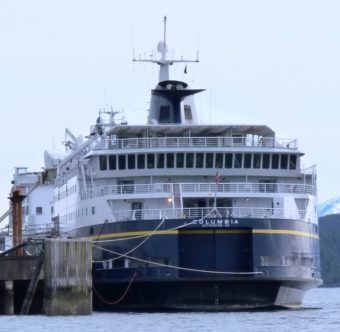
Budget cuts mean several Alaska Marine Highway System vessels will be docked this year. One of them is home to the system that collects data for ocean acidification researchers. But there’s a plan to keep that system running.
When it comes to collecting data, more is better. Especially when the data points are consistent. So the bow of Alaska Marine Highway System’s M/V Columbia is a good location for testing equipment that measures ocean acidification.
Wiley Evans is the oceanographer who runs the program for Hakai Institute in British Columbia.
“It is a unique data set,” he said. “And I can’t think of another one that is so well resolved.”
He calls the Columbia a ship of opportunity. That means it has its designated purpose — a ferry — but it does research on the side.
It’s all open data. So Evans and researchers from all over can track changes in ocean acidification, which has been called climate change’s evil twin. A global increase of CO2 in the atmosphere is decreasing the pH of ocean water. Evan’s data can help scientists understand its impact on fisheries and marine ecosystems.
“The Columbia has been going up and down every week, and you just get this fantastic picture of the variability that you would never get from going out on a research cruise for a month. It’s really, really fantastic,” he said.
He is especially interested in measuring data from the Lynn Canal. It’s the most variable zone on the whole coastline because of glacial melt and deep water.
The Columbia made regular thousand mile runs between Bellingham, Washington, and Skagway, and takes a water sample every two minutes. But now she is tied up in Ketchikan’s south berth for the foreseeable future.
Christy Harrington is the ferry system’s environmental specialist. And she’s not giving up on the project.
“We’re going to try to move the project to the Kennicott,” she said.
She says it’s the most extensive ferry-based CO2 testing system in North America. If their plan works out, it will grow. The Kennicott will take over the Bellingham to Skagway run in April, in addition to its other routes.
“So we’re not only going to have good data from the Bellingham run, but then we’ll get new data from crossing the Gulf [of Alaska] as well as down through the Aleutian Islands chain,” said Harrington.
The testing has been continuous for the last two years, but will take a winter hiatus. The Kennicott needs a winter overhaul. Harrington and Evans will need that time to move the equipment.
“Unfortunately, it’s not as simple as just going and grabbing the instrument off to Columbia and walking over to the Kennicott and putting it on the ship,” Evans said.
Evans estimates it could cost up to $150,000. There’s some engineering and shipyard work to make sure the equipment is installed correctly and taking measurements at the same depth as the Columbia did.
But Evans says the data is worth it. He will travel to Ketchikan this November to see if it’s possible to keep the data coming.
